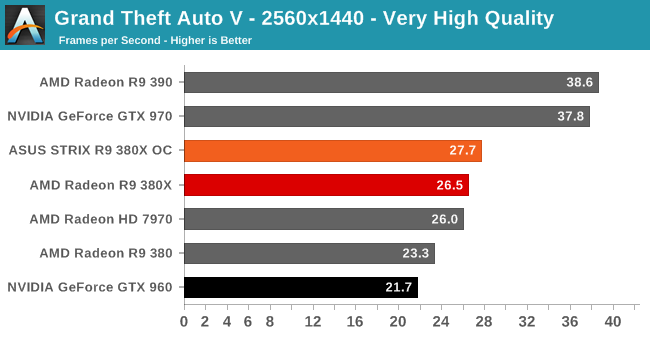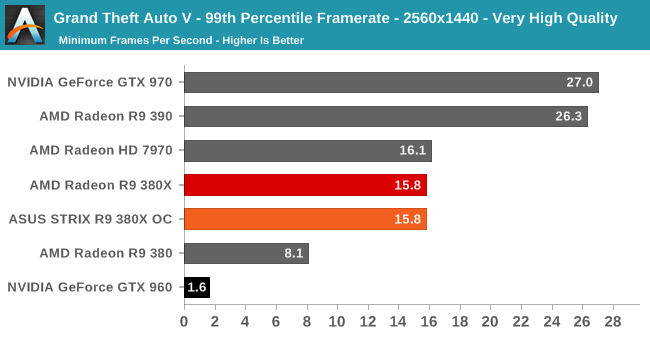The AMD Radeon R9 380X Review, Feat. ASUS STRIX
by Ryan Smith on November 23, 2015 8:30 AM EST- Posted in
- GPUs
- AMD
- Radeon
- Asus
- Radeon 300
Grand Theft Auto V
The open world action game in our benchmark suite is also the last game in our suite: Grand Theft Auto V. The latest edition of Rockstar’s venerable series of open world games, Grand Theft Auto V was originally released to the last-gen consoles back in 2013. However thanks to a rather significant facelift for the current-gen consoles and PCs, along with the ability to greatly turn up rendering distances and add other features like MSAA and more realistic shadows, the end result is a game that is still among the most stressful of our benchmarks when all of its features are turned up.
On a quick note about settings, as Grand Theft Auto V doesn't have pre-defined settings tiers, I want to quickly note what settings we're using. For "Very High" quality we have all of the primary graphics settings turned up to their highest setting, with the exception of grass, which is at its own very high setting. Meanwhile 4x MSAA is enabled for direct views and reflections. This setting also involves turning on some of the advanced redering features - the game's long shadows, high resolution shadows, and high definition flight streaming - but not increasing the view distance any further.


Grand Theft Auto V is another game that punishes 2GB cards to a degree, which plays into the R9 380X’s favor. At 1080p this helps to keep the card 11% ahead of the GTX 960 and 5% ahead of the R9 380. That said, GTA is the one game where perhaps even the R9 380X isn’t powerful enough for no-compromises 1080p gaming, and while 38fps is more than playable (this was a 30fps console game), the 60fps PC standard will require giving up MSAA to hit that mark.


Meanwhile the 99th percentile framerates further drive home the point about 2GB cards being insufficient. However it also points out how even the R9 380X can’t stay above 30fps at all times, reiterating what we said above about possibly needing to drop MSAA to get the best 1080p performance on the R9 380X.










101 Comments
View All Comments
Asomething - Tuesday, November 24, 2015 - link
The HSA foundation is partially founded by ARM which means they are already working on it (but as you said there isnt much motivation to make HSA enabled apps). AMD is the only high profile and headline grabbing member of it so they tend to get the most press because of clickbait articles. And a lot (if not all) of nvidia's efficiency improvements do come from the lower transistor density (also the main reason they can say their TDP is so low since the chip has a larger surface area with which to dissipate the same amount of heat as the same chip made using AMD's high density libraries would have), improvements to the memory and reductions in DP capabilities.tamalero - Tuesday, November 24, 2015 - link
anyone can explain me why everyone says the new gpus are overpriced?their pricepoints seems to be similar to the performance of the nvidia cards.
the table on the first page shows clearly.
Even the review shows the 970 and the AMD 390 trading blows and have the same price point.
so, what did I miss? why suddenly fanboys demand even 15% reduction to "become competitive" ?
FriendlyUser - Tuesday, November 24, 2015 - link
As everyone has noted, the cards are uncomfortably close to the higher tier (390 and 970). So, the 380X is not overpriced with respect to the competition from nvidia, but with respect to the 390. The jump in performance is so great, that we should either hope the 390 goes at $300 (practically eliminating the 380X) or the 380X completely dominates the sub-200 territory.Anyway, overall it's a very good product.
just4U - Friday, November 27, 2015 - link
Well.. here in Canada that's not quite the case. A 380/960 /w 4G mem sells for 300ish.. the 380X $330.A 970 runs you $450-500 and a 390 $430+ No way their priced similar to the 970/390.
BurntMyBacon - Tuesday, November 24, 2015 - link
@Samus: "They need to drop the prices across the entire line about 15% just to become competitive."That wouldn't fix the biggest pricing problem shown in this review. The 380X is priced too closely to the 390 given the performance difference. Drop them both by 15% and the 380X is still priced too closely to the 390. I'll leave the rest of you to argue performance vs premium cooler value on the high end and 390/390X vs GTX970/GTX980 performance per dollar, but I submit that a flat 15% drop is too simple an answer to the problem due to competition within their own lineup.
Azix - Wednesday, January 13, 2016 - link
but people were fine with the 960 at the same price...zeeBomb - Monday, November 23, 2015 - link
Ryan smith blessed us with a great graphics card review.maecenas - Monday, November 23, 2015 - link
At this point, NVIDIA or AMD, I'm not sure I would get anything other than an ASUS cooling system. I have the STRIX version of the GTX 970 and it really is fantastic.jasonelmore - Monday, November 23, 2015 - link
It Depends on what you need. The Stock Blower Coolers keep hot air out of the case, so for Small Form Factor Builds, your not going to want Asus's coolers since they dump the hot air back into the case.theduckofdeath - Tuesday, December 1, 2015 - link
I have a mATX case with water cooling and internal padding all around to keep the noise down, and my ASUS Strix GTX 960 is not making a sound and the temp in the case does not go above 50-52 degrees celsius even after hours of playing. The problem with GPUs sucking air out from the rear and blowing the same air out is, they have to generate all of the airflow themselves, which always gets really noisy compared to using the air passing through a case.